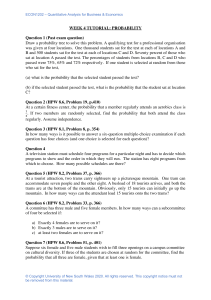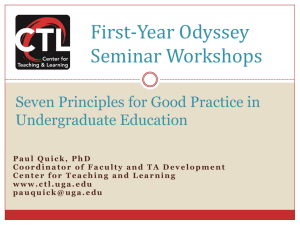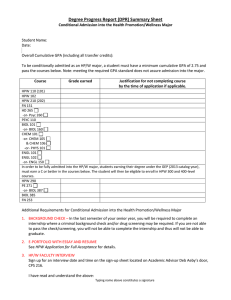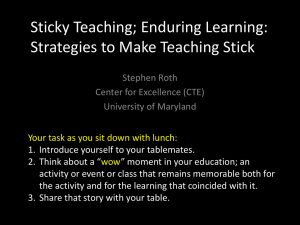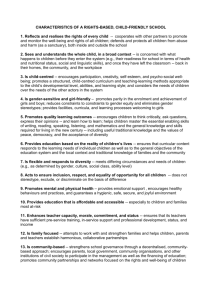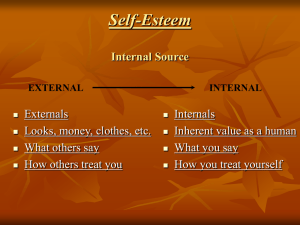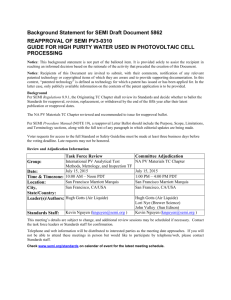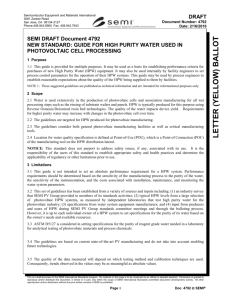Improving Student Engagement Briefing Paper
advertisement
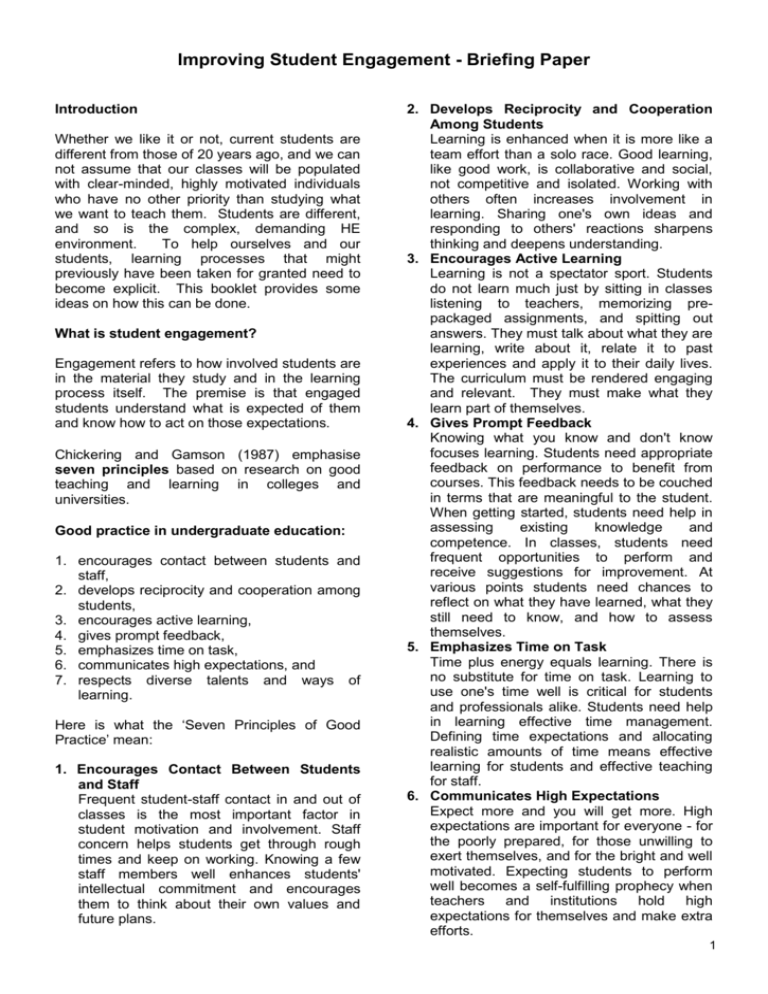
Improving Student Engagement - Briefing Paper Introduction Whether we like it or not, current students are different from those of 20 years ago, and we can not assume that our classes will be populated with clear-minded, highly motivated individuals who have no other priority than studying what we want to teach them. Students are different, and so is the complex, demanding HE environment. To help ourselves and our students, learning processes that might previously have been taken for granted need to become explicit. This booklet provides some ideas on how this can be done. What is student engagement? Engagement refers to how involved students are in the material they study and in the learning process itself. The premise is that engaged students understand what is expected of them and know how to act on those expectations. Chickering and Gamson (1987) emphasise seven principles based on research on good teaching and learning in colleges and universities. Good practice in undergraduate education: 1. encourages contact between students and staff, 2. develops reciprocity and cooperation among students, 3. encourages active learning, 4. gives prompt feedback, 5. emphasizes time on task, 6. communicates high expectations, and 7. respects diverse talents and ways of learning. Here is what the ‘Seven Principles of Good Practice’ mean: 1. Encourages Contact Between Students and Staff Frequent student-staff contact in and out of classes is the most important factor in student motivation and involvement. Staff concern helps students get through rough times and keep on working. Knowing a few staff members well enhances students' intellectual commitment and encourages them to think about their own values and future plans. 2. Develops Reciprocity and Cooperation Among Students Learning is enhanced when it is more like a team effort than a solo race. Good learning, like good work, is collaborative and social, not competitive and isolated. Working with others often increases involvement in learning. Sharing one's own ideas and responding to others' reactions sharpens thinking and deepens understanding. 3. Encourages Active Learning Learning is not a spectator sport. Students do not learn much just by sitting in classes listening to teachers, memorizing prepackaged assignments, and spitting out answers. They must talk about what they are learning, write about it, relate it to past experiences and apply it to their daily lives. The curriculum must be rendered engaging and relevant. They must make what they learn part of themselves. 4. Gives Prompt Feedback Knowing what you know and don't know focuses learning. Students need appropriate feedback on performance to benefit from courses. This feedback needs to be couched in terms that are meaningful to the student. When getting started, students need help in assessing existing knowledge and competence. In classes, students need frequent opportunities to perform and receive suggestions for improvement. At various points students need chances to reflect on what they have learned, what they still need to know, and how to assess themselves. 5. Emphasizes Time on Task Time plus energy equals learning. There is no substitute for time on task. Learning to use one's time well is critical for students and professionals alike. Students need help in learning effective time management. Defining time expectations and allocating realistic amounts of time means effective learning for students and effective teaching for staff. 6. Communicates High Expectations Expect more and you will get more. High expectations are important for everyone - for the poorly prepared, for those unwilling to exert themselves, and for the bright and well motivated. Expecting students to perform well becomes a self-fulfilling prophecy when teachers and institutions hold high expectations for themselves and make extra efforts. 1 7. Respects Diverse Talents and Ways of Learning There are many roads to learning. People bring different talents and styles of learning to college. Brilliant students in seminars may be all thumbs in the lab or studio. Students rich in hands-on experience may not do so well with theory. Students need the opportunity to show their talents and learn in ways that work for them. Then they can be pushed to learn in new ways that do not come so easily. Some Suggestions for Improving Student Engagement1 Academic Challenge expectations for student performance clearly and consistently articulated and set at appropriately high levels; as these levels are met, new challenges need to be introduced to move the student on further student time on task consistent with staff expectations and course demands emphasis in classes on higher-order cognitive and intellectual activities challenging examinations and assignments students “stretched” to meet academic standards and expectations academic challenges for students balanced by appropriate support Active Learning and Collaborative Learning active learning expected and practiced throughout the curriculum students taught how to participate actively and collaboratively in class electronic technologies foster active learning group study and other forms of collaboration encouraged by physical and curriculum structures and facilitated by effective access, electronically or face to face students provide feedback to their peers Student-Staff Interaction staff physically and psychologically accessible to students staff meet with students outside of class staff collaborate on research with undergraduates students receive extensive and timely feedback from staff Students are recognised by staff as individuals with a variety of abilities and limitations a variety of means of communication is readily available: face to face and on-line Enriching Educational Experiences diversity experiences are infused in the curriculum and co-curriculum students required to participate in courses and/or activities that promote civic engagement students take advantage of work-related learning opportunities (eg Study abroad, Placements, Site visits, Simulations) extracurricular experiences enrich student learning students have opportunities to develop leadership skills Case Study Example 1 - Increasing Student Engagement in Large Classes: a 2 Departmental Case Study. Over the last several years, the University of Colorado at Boulder's Physics Department has worked hard to improve student learning in the large-lecture introductory physics courses (600 students). Our main focus has been on increasing interactive engagement in lectures and on promoting collaborative learning. In addition, some courses have incorporated a variety of other practices based on Physics Education Research (PER) findings. These include: emphasizing conceptual understanding, explicitly teaching metacognitive skills, incorporating conceptual and context-rich (realworld) problems in homework, using computer simulations, developing well-defined course goals, and measuring learning gains and student attitudes with validated assessment instruments. In 1997, several staff members began promoting the use of interactive methods in the classroom. They cited the improved learning gains reported by others using Eric Mazur's Peer Instruction method and began using such techniques. Each year since then additional staff members have adopted this style of lecture. Students vote on answers to questions during the lecture, that 1) quiz on the reading, 2) elicit/reveal misconceptions, 3) test conceptual understanding, 4) require prediction of experimental outcomes or simulation response, 5) recall a lecture point, 6) require reasoning to apply concepts in different contexts, 7) relate 1 Adapted from Kuh, G D Taking Stock of What Matters to Student Success: http://www.auqa.edu.au/auqf/2006/student/kuh_taking_stock_of_w hat_matters.pdf 2 Adapted from Pollock and Perkins (2004) 2 different representations, 8) do a calculation, 9) draw on intuition from everyday life, and 10) survey students. The mix and types of questions used varies with course and instructor, but peer discussion related to the questions ensues. In some courses, this simply means that students discuss their ideas with neighbours. In other courses, groups of 3-4 students are formed and are required to come to a consensus before voting. Some instructors follow up questions with teacher-led, full-class discussions. In addition, some staff use interactive lecture demonstrations which require each student to graph or otherwise predict the measured outcomes of an experiment. This increased emphasis on collaborative learning exists outside the lecture hall as well. In 2000, the department created a public Physics Help Room for all introductory classes. Open 9 am to 5 pm and staffed by instructors and TAs, the "Help Room" is extremely popular. Typically thirty to ninety students are present in the room. Often they are working together in small groups. In addition, most of our introductory courses make use of CAPA, a computerized homework system which personalizes problems. This further encouraging a culture of student collaboration since students can work together on problems without feeling like someone is copying the work of another. In fall 2003, traditional recitations in the calculus-based mechanics course were replaced with tutorials run by TAs and undergraduate learning assistants. Incorporating these new teaching methods has not had any adverse effects on course or instructor ratings. In fact, on average our interactive engagement-based courses rate higher than the traditional lecture-based courses on student evaluations. The department now holds bi-weekly brown bag lunch meetings where interested staff members can discuss education issues. Local physics education researchers are often invited to speak. Typical attendance at the "brown bag" meetings is up to 30% of the staff. This is an informal but powerful forum for sharing interest and ideas, spreading pedagogical theories and practical approaches, and encouraging reflection on individual and departmental practices. The department also began inviting high-profile colloquia speakers. These colloquia had a noticeable impact and were well attended by the staff. Providing forums for dissemination of ideas - hallway discussions, colloquia, and lunch meetings - has certainly contributed to the spread of interest in and awareness of new teaching methods. For more information on our group, please visit our web page at www.colorado.edu/physics/EducationIssues. We welcome feedback on efforts at other institutions to implement sustainable and effective change. Case Study 2 – The Struggling Fourth Year A final year student’s work and attendance are poor and she’s constantly tired, and it is discovered that she has no money or parental support and is working long hours at Tesco. Once the problem is identified, the mentor passes the student to Student Welfare Services, where she discovers that 4th year students are prioritised for the (non-repayable) Student Hardship Fund Grant. Once she stopped working at Tesco (given the £1000 grant) her work rapidly improved. Case Study 3 – Notional Study Hours Students often don’t understand that studying on a particular module involves more than turning up for classes. So remind them regularly about notional study hours. Eg a 15 credit module entails 150 hours of study. This could be broken up as 12.5 hpw: 2 hpw lecture 2 hpw tutorial/ lab 1 hpw VISION activities 3 hpw assessment activities (formative/ summative/ revision for exams) 4.5 hpw independent study (including prep for classes) Discuss with students what they’re meant to be doing in their independent study time. Links Chickering A W and Gamson Z F, (1987) Seven Principles for Good Practice in Undergraduate Educaiton: http://honolulu.hawaii.edu/intranet/committees/F acDevCom/guidebk/teachtip/7princip.htm Pollock, S and Perkins, K (2004) Increasing student engagement in large classes: A departmental case study. Forum on Education of the American Physical Society. At Physics Education Research @ Colorado: http://www.colorado.edu/physics/EducationIssue s/research/papers_talks.htm (Last accessed 12 Feb 2007) 3 What to do now? 1. Using the Planning Tool, work out what currently goes on in your course in trying to engage students in their learning. 2. Decide which other approaches and methods would work in your subject area. 3. Plan how they will map across the course, developing engagement activities at each level. 4. Make sure that the approach is explicit and understood by students and colleagues: they are more likely to engage with tasks if they can see the point of them. 4
